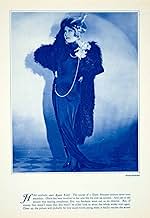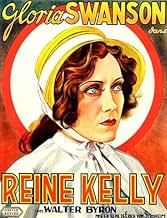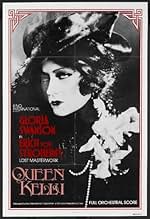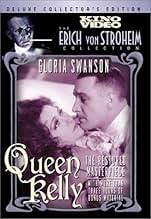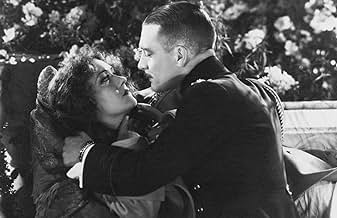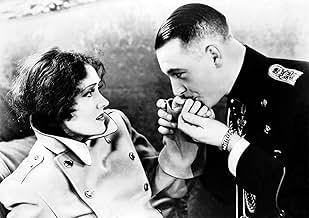VALUTAZIONE IMDb
7,1/10
3439
LA TUA VALUTAZIONE
Aggiungi una trama nella tua linguaA convent girl is abducted and seduced by a prince before being sent off to a brothel in East Africa.A convent girl is abducted and seduced by a prince before being sent off to a brothel in East Africa.A convent girl is abducted and seduced by a prince before being sent off to a brothel in East Africa.
- Regia
- Sceneggiatura
- Star
- Premi
- 1 vittoria in totale
Sylvia Ashton
- Kelly's Aunt
- (non citato nei titoli originali)
Wilson Benge
- Prince Wolfram's Valet
- (non citato nei titoli originali)
Sidney Bracey
- Prince Wolfram's Lackey
- (non citato nei titoli originali)
Rae Daggett
- Coughdrops
- (non citato nei titoli originali)
Robert Frazier
- Catholic Priest
- (non citato nei titoli originali)
Florence Gibson
- Kelly's Aunt
- (non citato nei titoli originali)
Madge Hunt
- Mother Superior
- (non citato nei titoli originali)
Tully Marshall
- Jan Vryheid
- (non citato nei titoli originali)
Ann Morgan
- Maid Escorting Kelly to Altar
- (non citato nei titoli originali)
Madame Sul-Te-Wan
- Kali Sana - Aunt's Cook
- (non citato nei titoli originali)
Lucille Van Lent
- Prince Wolfram's Maid
- (non citato nei titoli originali)
Wilhelm von Brincken
- Prince Wolfram's Adjutant
- (non citato nei titoli originali)
Gordon Westcott
- Lackey
- (non citato nei titoli originali)
Recensioni in evidenza
I'd imagine that most people who would come to this page to read a review of Erich Von Stroheim's unfinished epic Queen Kelly already know something about it, but nonetheless it seems a little historical context is necessary before attempting to critique the fragment that remains. This was a deeply troubled project, memorably described by leading lady Gloria Swanson as a child that refused to be born. Set in a fictitious 'Middle European' kingdom, the first portion of Von Stroheim's screenplay tells a fairy tale-like story of an innocent convent girl, Patricia Kelly, who becomes involved with a wastrel Prince-- who, unbeknownst to her, is already betrothed to the Queen. At first the Prince wants only to toy with Kelly, but in the course of their one evening together he sincerely falls in love with her. Unfortunately, the mad Queen Regina learns of the affair and literally flogs Kelly out of the palace. Kelly attempts suicide, but is rescued and abruptly sent to German East Africa, where her dying aunt runs a brothel. She is forced to marry a syphilitic plantation owner and eventually winds up successfully running the brothel herself, under the ironic moniker "Queen Kelly."
As originally scripted this film might have run as long as five hours, so the portion available today represents barely one-third of the intended opus. The project marked the sole collaboration between writer/director Von Stroheim, star/producer Swanson, and co-producer Joseph P. Kennedy, patriarch of the political dynasty (who was also Swanson's lover at the time). Plans for this silent epic were launched at the end of 1927, but by the time shooting began in fall of 1928 the talkie revolution was sweeping Hollywood, and this would prove to be perhaps the biggest single factor that doomed the project to limbo. Three months into the filming Von Stroheim was fired, and for the next few years Swanson attempted to finish the movie in various ways, finally releasing a truncated version in Europe in 1932. In the 1960s about twenty minutes' worth of footage from the sequence set in Africa was discovered, and this material was reunited with the earlier portion in a restored version completed in 1985.
Given this history it seems almost unfair to critique what remains of Queen Kelly at all, but the restoration presents a rough idea of what the movie might have amounted to in its longer form. This is a fascinating fragment with both positive and negative aspects.
On the positive side, the film is beautiful to look at; Paul Ivano's gleaming cinematography ranks with the best work of the era. Practically every shot boasts features of striking interest, and the production design teems with the sort of character-revealing detail for which Von Stroheim was known. Befitting the unreal atmosphere, Seena Owen and Tully Marshall offer highly stylized character turns as Queen Regina and plantation owner Jan Vryheid. Owen's Mad Queen is unforgettable, lounging about the palace nude (while toting a strategically positioned white cat!), surrounded by erotic art and brandishing a riding crop. Marshall's scenes are limited to a few minutes in the recovered 'Africa' footage, but he etches a vivid portrait of creepy decadence.
On the debit side, however, is the central and insurmountable problem that Gloria Swanson was miscast in the title role: she simply isn't credible as the innocent convent girl the story demands. Kelly is supposed to be a sheltered girl who has never tasted champagne. Swanson was 31 years old when this film was made and, frankly, looked older. Even in films she made in her early 20s she comes off as a tough cookie who could handle anything, but here, alongside the actual girls who are supposed to be her contemporaries, Gloria looks like she should be playing the Mother Superior. Von Stroheim's leading lady from The Wedding March, 21 year-old Fay Wray, would have been perfect as Kelly, but once producer Swanson cast herself in the role the project was inherently flawed.
Another problem is that most of this material was edited together only after Von Stroheim had been fired and the production shut down, when Swanson was attempting to assemble a marketable feature-length movie out of the opening 'Middle Europe' section. Originally these scenes had been intended to serve as little more than a prologue to the Africa story, but since it was the only portion completed the editors were forced to extend what they had to pad the running time. There is much lingering over details and too many prolonged reaction shots, especially in the scenes between Kelly and the Prince. It's said that when Erich Von Stroheim saw this version of the film in later years he complained that the pace was far too slow, and so it appears today: sumptuously photographed but draggy, despite the occasional high points.
In sum, while I would call this film a must for silent movie buffs, I don't believe the average viewer would find much to enjoy in Queen Kelly. This is one of those legendary disasters with a "backstory" rather more interesting than what we see on screen. In that light I can especially recommend watching the recent DVD release with film scholar Richard Koszarski's commentary accompanying the visuals, to help make sense of it all.
As originally scripted this film might have run as long as five hours, so the portion available today represents barely one-third of the intended opus. The project marked the sole collaboration between writer/director Von Stroheim, star/producer Swanson, and co-producer Joseph P. Kennedy, patriarch of the political dynasty (who was also Swanson's lover at the time). Plans for this silent epic were launched at the end of 1927, but by the time shooting began in fall of 1928 the talkie revolution was sweeping Hollywood, and this would prove to be perhaps the biggest single factor that doomed the project to limbo. Three months into the filming Von Stroheim was fired, and for the next few years Swanson attempted to finish the movie in various ways, finally releasing a truncated version in Europe in 1932. In the 1960s about twenty minutes' worth of footage from the sequence set in Africa was discovered, and this material was reunited with the earlier portion in a restored version completed in 1985.
Given this history it seems almost unfair to critique what remains of Queen Kelly at all, but the restoration presents a rough idea of what the movie might have amounted to in its longer form. This is a fascinating fragment with both positive and negative aspects.
On the positive side, the film is beautiful to look at; Paul Ivano's gleaming cinematography ranks with the best work of the era. Practically every shot boasts features of striking interest, and the production design teems with the sort of character-revealing detail for which Von Stroheim was known. Befitting the unreal atmosphere, Seena Owen and Tully Marshall offer highly stylized character turns as Queen Regina and plantation owner Jan Vryheid. Owen's Mad Queen is unforgettable, lounging about the palace nude (while toting a strategically positioned white cat!), surrounded by erotic art and brandishing a riding crop. Marshall's scenes are limited to a few minutes in the recovered 'Africa' footage, but he etches a vivid portrait of creepy decadence.
On the debit side, however, is the central and insurmountable problem that Gloria Swanson was miscast in the title role: she simply isn't credible as the innocent convent girl the story demands. Kelly is supposed to be a sheltered girl who has never tasted champagne. Swanson was 31 years old when this film was made and, frankly, looked older. Even in films she made in her early 20s she comes off as a tough cookie who could handle anything, but here, alongside the actual girls who are supposed to be her contemporaries, Gloria looks like she should be playing the Mother Superior. Von Stroheim's leading lady from The Wedding March, 21 year-old Fay Wray, would have been perfect as Kelly, but once producer Swanson cast herself in the role the project was inherently flawed.
Another problem is that most of this material was edited together only after Von Stroheim had been fired and the production shut down, when Swanson was attempting to assemble a marketable feature-length movie out of the opening 'Middle Europe' section. Originally these scenes had been intended to serve as little more than a prologue to the Africa story, but since it was the only portion completed the editors were forced to extend what they had to pad the running time. There is much lingering over details and too many prolonged reaction shots, especially in the scenes between Kelly and the Prince. It's said that when Erich Von Stroheim saw this version of the film in later years he complained that the pace was far too slow, and so it appears today: sumptuously photographed but draggy, despite the occasional high points.
In sum, while I would call this film a must for silent movie buffs, I don't believe the average viewer would find much to enjoy in Queen Kelly. This is one of those legendary disasters with a "backstory" rather more interesting than what we see on screen. In that light I can especially recommend watching the recent DVD release with film scholar Richard Koszarski's commentary accompanying the visuals, to help make sense of it all.
Queen Kelly (1929)
*** (out of 4)
I think it's safe to say that von Stroheim's directing career was over when Gloria Swanson threw him a bone to direct this picture, which was originally intended to be a five-hour epic. Soon, as was always the case with the director, the thing was way over budget, he was fired and the film was never completed, although a few years later Swanson went back and filmed an alternate ending, which is included on the DVD. The film, as presented on the DVD, runs around 100-minutes and I'd say about ten-minutes are made up from stills and title cards explaining the missing footage.
The film tells the story of Kitty Kelly (Swanson), a convent girl who gets swept off her feet by Prince Wolfram (Walter Byron) but she does know that he's set to marry Queen Regina (Seena Owen) the following day. Kelly runs away in shame and finds herself in South Africa where her dying aunt turns over her brothel, which Kelly will now run. The love at first site plot isn't the most original out there but von Stroheim adds enough weirdness that makes this film worth sitting through. You can tell that this was meant to be an epic because of the 90-minutes worth of footage the first seventy-minutes are pretty much dealing with the love story. I'm guessing Kelly's rise in the brothel was originally meant to be much longer than what's shown here but I guess we'll never know as the footage is long gone and what stills are available really don't tell us too much. There are many flaws in this film but for the most part I found it very enjoyable. I thought the opening fifteen-minutes were a tad bit stiff but things really start to heat up around the thirty-minute mark. The sadistic side of von Stroheim comes through when the Queen learns that her man has been unfaithful and the whipping sequence she puts on Kelly is marvelously done and is without question one of the most beautiful shots in the director's career. You can also easily see where the budget went and the incredibly banquet scene is just a real beauty on the eyes. Swanson turns in a very good performance as she perfectly captures the spirit of the young, naive girl, although at the same time she's way too old for the part. I thought she handled the role very nicely but we never really get to see her as the brothel queen. Both Byron and especially Owen eat up their scenes and help keep the film moving. As is, QUEEN KELLY is certainly flawed but it's hard to judge the film too much simply because most of it is incomplete. The "Swanson" ending that's included on the DVD really doesn't work either so in the end we're just left with a "what if..." situation.
*** (out of 4)
I think it's safe to say that von Stroheim's directing career was over when Gloria Swanson threw him a bone to direct this picture, which was originally intended to be a five-hour epic. Soon, as was always the case with the director, the thing was way over budget, he was fired and the film was never completed, although a few years later Swanson went back and filmed an alternate ending, which is included on the DVD. The film, as presented on the DVD, runs around 100-minutes and I'd say about ten-minutes are made up from stills and title cards explaining the missing footage.
The film tells the story of Kitty Kelly (Swanson), a convent girl who gets swept off her feet by Prince Wolfram (Walter Byron) but she does know that he's set to marry Queen Regina (Seena Owen) the following day. Kelly runs away in shame and finds herself in South Africa where her dying aunt turns over her brothel, which Kelly will now run. The love at first site plot isn't the most original out there but von Stroheim adds enough weirdness that makes this film worth sitting through. You can tell that this was meant to be an epic because of the 90-minutes worth of footage the first seventy-minutes are pretty much dealing with the love story. I'm guessing Kelly's rise in the brothel was originally meant to be much longer than what's shown here but I guess we'll never know as the footage is long gone and what stills are available really don't tell us too much. There are many flaws in this film but for the most part I found it very enjoyable. I thought the opening fifteen-minutes were a tad bit stiff but things really start to heat up around the thirty-minute mark. The sadistic side of von Stroheim comes through when the Queen learns that her man has been unfaithful and the whipping sequence she puts on Kelly is marvelously done and is without question one of the most beautiful shots in the director's career. You can also easily see where the budget went and the incredibly banquet scene is just a real beauty on the eyes. Swanson turns in a very good performance as she perfectly captures the spirit of the young, naive girl, although at the same time she's way too old for the part. I thought she handled the role very nicely but we never really get to see her as the brothel queen. Both Byron and especially Owen eat up their scenes and help keep the film moving. As is, QUEEN KELLY is certainly flawed but it's hard to judge the film too much simply because most of it is incomplete. The "Swanson" ending that's included on the DVD really doesn't work either so in the end we're just left with a "what if..." situation.
Erich von Stroheim's infamous final stab at direction (unfinished, when the plug was pulled by producer and star Gloria Swanson) is a sophisticated piece of silent cinema, wrapped in a camp plot and looking fabulous.
Gloria Swanson plays Patricia Kelly, a convent girl who meets the Prince of her dreams ('wild' Wolfram, played by Walter Byron) while she is out with the nuns. After a risqué scene concerning the soldiers and her bloomers, Gloria prays to the Holy Virgin to let her see the Prince again, while the Prince feels trapped in his engagement to the mad Queen Regina (a scene-chewing Seena Owen).
The first half of the film concerns how 'Kelly' and Wolfram come to meet up again, this time in the Palace where the jealous Queen loses no time in whipping Kelly out of doors and roaring that the Prince is 'Mine, MINE, MINE!'. The second half (unfinished) concerns Kelly's fortunes thereafter, called by her dying aunt to Africa where she finds herself in a brothel and betrothed to loathsome cripple drunk Jan Vryheid (a repellent and compelling performance from Tully Marshall), and eventually (and improbably) turns the situation round to get her happy ending, 'Queen Kelly' again.
Gloria Swanson looks absolutely gorgeous in the shimmering black and white close-ups, and her acting as Kelly is impeccable throughout - no one made better use of the 'look of horror' or the 'dipping of eyelashes' or the 'flirty smile'. Walter Byron is a moustachioed hero in the mould of John Gilbert and is an amusing second lead.
With the gaps plugged by wordy slides (in some prints, Kelly becomes Kitty in these explanatory bits, but never mind ...) and still photographs, 'Queen Kelly' is a boisterous and worthy final feature for its director. Many have seen a small bit of this film as part of Norma Desmond's home projections in 'Sunset Boulevard', but try to see the full thing - hugely enjoyable, and if not as mushily romantic as 'The Wedding March', its satirical splendor more than makes up for it!
Gloria Swanson plays Patricia Kelly, a convent girl who meets the Prince of her dreams ('wild' Wolfram, played by Walter Byron) while she is out with the nuns. After a risqué scene concerning the soldiers and her bloomers, Gloria prays to the Holy Virgin to let her see the Prince again, while the Prince feels trapped in his engagement to the mad Queen Regina (a scene-chewing Seena Owen).
The first half of the film concerns how 'Kelly' and Wolfram come to meet up again, this time in the Palace where the jealous Queen loses no time in whipping Kelly out of doors and roaring that the Prince is 'Mine, MINE, MINE!'. The second half (unfinished) concerns Kelly's fortunes thereafter, called by her dying aunt to Africa where she finds herself in a brothel and betrothed to loathsome cripple drunk Jan Vryheid (a repellent and compelling performance from Tully Marshall), and eventually (and improbably) turns the situation round to get her happy ending, 'Queen Kelly' again.
Gloria Swanson looks absolutely gorgeous in the shimmering black and white close-ups, and her acting as Kelly is impeccable throughout - no one made better use of the 'look of horror' or the 'dipping of eyelashes' or the 'flirty smile'. Walter Byron is a moustachioed hero in the mould of John Gilbert and is an amusing second lead.
With the gaps plugged by wordy slides (in some prints, Kelly becomes Kitty in these explanatory bits, but never mind ...) and still photographs, 'Queen Kelly' is a boisterous and worthy final feature for its director. Many have seen a small bit of this film as part of Norma Desmond's home projections in 'Sunset Boulevard', but try to see the full thing - hugely enjoyable, and if not as mushily romantic as 'The Wedding March', its satirical splendor more than makes up for it!
Eric Von Stroheim (1885-1957) was among the silent era's most visionary, artistically ambitious directors; Gloria Swanson (1897-1983) was among the screen's first "divas" and one of the silent era's greatest stars. With Swanson's lover Joe Kennedy (father of John, Robert and Ted) acting as money man, Von Stroheim and Swanson teamed to create a film that both believed would be crowing achievement of their careers: QUEEN KELLY.
Less than a third of the script was filmed when Swanson called Kennedy and demanded that Von Stroheim be fired. He was, and in his absence Swanson filmed several scenes intended to round out the story line and make the film fit for release. In doing so she reckoned with Von Stroheim, who had cannily held copyright and who flatly refused to permit distribution--and as the battle wore on sound began to roar, making the film less commercially viable with every passing day. Swanson was eventually able to release QUEEN KELLY in Europe, but it generated little interest and was soon withdrawn. It would not be seen in America until after Von Stroheim's death. It would be Von Stroheim's last major work as a director and it would effectively end Swanson's film career for a decade or more.
In the interval the reputation of QUEEN KELLY began to grow. It was, many declared, a lost masterpiece much like Von Stroheim's legendary GREED. And when it at last became widely available it leaped onto every critic and buff's short list of "important" silent movies. But time has a way of smoothing out peaks and valleys. Seen today, QUEEN KELLY is interesting--but only for what it might have been, not for what it actually is.
The story is distinctly odd. Prince Wolfram (Walter Byron) is betrothed to Queen Regina (Seena Owen), a vicious, half-mad, and intensely despot he despises. While riding in the country he comes upon a group of orphans that includes Kitty Kelly (Gloria Swanson), who makes an impression on him by loosing her bloomers and then angrily throwing them in his face when he laughs at her. Determined to see her again, the Prince stages a fire in the convent and under cover of smoke kidnaps Kitty and takes her to the palace, where she soon surrenders to his charms. But there is hell to pay when Queen Regina discovers the girl, and before you know it Prince Wolfram is in the dungeon and Kitty has, of all things, inherited a brothel in Africa. Will they find each other again? It is basically at this point that the film footage ends. The Kino release attempts to finish out the story with a handful of stills and title cards, and true enough we do learn the outcome of the story--but it is a very academic proposition, to say the very least, and although it seems to have a certain promise it is very hard to say what Stroheim might have done with the rest of the story. Hopefully more than he was able to do with the first third! For while the existing footage is not bad, it hardly compares with either Stroheim or Swanson at their finest.
Indeed, Swanson seems extremely miscast in the title role. It is utterly impossible to accept her as an innocent orphan raised in a convent. Much more interesting is Seena Owen as the evil Queen Regina, who is sullen, dangerous, and utterly fascinating; in the film's most memorable scene, in which Kitty is chased through the palace by the whip-wielding Queen, it is Owen who dominates the scene, not Swanson. As for Von Stroheim, he is clearly building a series of visual motifs that reference sex, most notably in his use of candles, fires, and smoke--but with the film suddenly unfinished it is very difficult to know to what end he intended it.
This is really a film for silent film connoisseurs, and even they may find it frustrating to the point of annoyance. The Kino print is very good, but there is no getting around the fact that the film itself ends at the very point at which our interest in both plot and characters begins to build. Recommended, but as a curiosity only. Trivia: some twenty years later Swanson and Von Stroheim co-starred in the legendary SUNSET BLVD--and the film that silent star Norma Desmond watches is none other QUEEN KELLY.
Gary F. Taylor (aka GFT, Amazon Reviewer)
Less than a third of the script was filmed when Swanson called Kennedy and demanded that Von Stroheim be fired. He was, and in his absence Swanson filmed several scenes intended to round out the story line and make the film fit for release. In doing so she reckoned with Von Stroheim, who had cannily held copyright and who flatly refused to permit distribution--and as the battle wore on sound began to roar, making the film less commercially viable with every passing day. Swanson was eventually able to release QUEEN KELLY in Europe, but it generated little interest and was soon withdrawn. It would not be seen in America until after Von Stroheim's death. It would be Von Stroheim's last major work as a director and it would effectively end Swanson's film career for a decade or more.
In the interval the reputation of QUEEN KELLY began to grow. It was, many declared, a lost masterpiece much like Von Stroheim's legendary GREED. And when it at last became widely available it leaped onto every critic and buff's short list of "important" silent movies. But time has a way of smoothing out peaks and valleys. Seen today, QUEEN KELLY is interesting--but only for what it might have been, not for what it actually is.
The story is distinctly odd. Prince Wolfram (Walter Byron) is betrothed to Queen Regina (Seena Owen), a vicious, half-mad, and intensely despot he despises. While riding in the country he comes upon a group of orphans that includes Kitty Kelly (Gloria Swanson), who makes an impression on him by loosing her bloomers and then angrily throwing them in his face when he laughs at her. Determined to see her again, the Prince stages a fire in the convent and under cover of smoke kidnaps Kitty and takes her to the palace, where she soon surrenders to his charms. But there is hell to pay when Queen Regina discovers the girl, and before you know it Prince Wolfram is in the dungeon and Kitty has, of all things, inherited a brothel in Africa. Will they find each other again? It is basically at this point that the film footage ends. The Kino release attempts to finish out the story with a handful of stills and title cards, and true enough we do learn the outcome of the story--but it is a very academic proposition, to say the very least, and although it seems to have a certain promise it is very hard to say what Stroheim might have done with the rest of the story. Hopefully more than he was able to do with the first third! For while the existing footage is not bad, it hardly compares with either Stroheim or Swanson at their finest.
Indeed, Swanson seems extremely miscast in the title role. It is utterly impossible to accept her as an innocent orphan raised in a convent. Much more interesting is Seena Owen as the evil Queen Regina, who is sullen, dangerous, and utterly fascinating; in the film's most memorable scene, in which Kitty is chased through the palace by the whip-wielding Queen, it is Owen who dominates the scene, not Swanson. As for Von Stroheim, he is clearly building a series of visual motifs that reference sex, most notably in his use of candles, fires, and smoke--but with the film suddenly unfinished it is very difficult to know to what end he intended it.
This is really a film for silent film connoisseurs, and even they may find it frustrating to the point of annoyance. The Kino print is very good, but there is no getting around the fact that the film itself ends at the very point at which our interest in both plot and characters begins to build. Recommended, but as a curiosity only. Trivia: some twenty years later Swanson and Von Stroheim co-starred in the legendary SUNSET BLVD--and the film that silent star Norma Desmond watches is none other QUEEN KELLY.
Gary F. Taylor (aka GFT, Amazon Reviewer)
This is Director Eric Von Stroheim's last film, produced by it's star, Gloria Swanson. There is much to be learned from the commentaries and additional features on the deluxe Kino DVD of this silent film. The film itself is a wonderful lesson in film-making of its period. Von Stroheim loved to take shots of all the props and costume details of a character believing that this focus on detail told you more about the character than the actor alone could convey. This technique was later perfected by Hitchcock, where details shots are followed by reaction shots to move the story and emotional life along.
QUEEN KELLY is the story of a convent girl who falls in love with a dissipated prince who is promised to a debauched Queen. By today's standard, Seena Owen's performance as the queen is laughably over the top; she slithers and glowers and when she's really angry, she seems to have something stuck in her eye. Swanson herself was the prototype of today's tiny body, big head build favored in television. In her long shots her build looks almost like a pygmy, especially in comparison to Owen. But Swanson has that riveting face, and remains really a fine actress. The interview sections done as introductions to a television viewing of QUEEN KELLY show her to have retained those gorgeous and expressive eyes. This was considered her last film as a real ingénue - she was a bit long in the tooth to be playing a convent girl - but that was the style, bless them.
The original story was only about 1/3 completed when the production went way over budget and delved into areas that would never be approved by censors. Arguably, given Seena Owen's almost 100% nude (wearing either chiffon negligee, or a strategically held cat) performance, most of it may not have passed censors.
The restoration makes much ado of finding reels from the abandoned "African brothel" sequences, but when all is said and done, the "Swanson Ending" (the only way it was shown after talkies had come in and silents were pretty much a done thing) is a very serviceable and good ending evoking Shakespearian tragedy. Most silents were big on action, short on story, with fairly simple plots. Granted the original was supposed to have a happy, if rather suspicious, happy ending, but this makes total sense, and makes Queen Kelly seem very complete.
The only real loss of the Swanson ending is losing the believably sick (in both senses of the word) performance of Tully Marshall. Between Owen and Marshall, it is a lesson in why the production "code of decency" was developed in the first place. The irony is that, as much as she may have been considered heavy handed or intrusive for firing Von Stoheim, Swanson's ending demonstrates that Swanson really did know what she was doing as a producer. A memorable and informative trip into film history.
If you're not interested in film history or silent film, skip it.
QUEEN KELLY is the story of a convent girl who falls in love with a dissipated prince who is promised to a debauched Queen. By today's standard, Seena Owen's performance as the queen is laughably over the top; she slithers and glowers and when she's really angry, she seems to have something stuck in her eye. Swanson herself was the prototype of today's tiny body, big head build favored in television. In her long shots her build looks almost like a pygmy, especially in comparison to Owen. But Swanson has that riveting face, and remains really a fine actress. The interview sections done as introductions to a television viewing of QUEEN KELLY show her to have retained those gorgeous and expressive eyes. This was considered her last film as a real ingénue - she was a bit long in the tooth to be playing a convent girl - but that was the style, bless them.
The original story was only about 1/3 completed when the production went way over budget and delved into areas that would never be approved by censors. Arguably, given Seena Owen's almost 100% nude (wearing either chiffon negligee, or a strategically held cat) performance, most of it may not have passed censors.
The restoration makes much ado of finding reels from the abandoned "African brothel" sequences, but when all is said and done, the "Swanson Ending" (the only way it was shown after talkies had come in and silents were pretty much a done thing) is a very serviceable and good ending evoking Shakespearian tragedy. Most silents were big on action, short on story, with fairly simple plots. Granted the original was supposed to have a happy, if rather suspicious, happy ending, but this makes total sense, and makes Queen Kelly seem very complete.
The only real loss of the Swanson ending is losing the believably sick (in both senses of the word) performance of Tully Marshall. Between Owen and Marshall, it is a lesson in why the production "code of decency" was developed in the first place. The irony is that, as much as she may have been considered heavy handed or intrusive for firing Von Stoheim, Swanson's ending demonstrates that Swanson really did know what she was doing as a producer. A memorable and informative trip into film history.
If you're not interested in film history or silent film, skip it.
Lo sapevi?
- QuizA clip from the film appears in Viale del tramonto (1950), where Norma Desmond (played by Gloria Swanson), a silent movie star who is planning a comeback, watches one of her former films. Erich von Stroheim plays Max Von Mayerling, Desmond's butler, who serves as projectionist for the film clip. It is later revealed that Max was the silent movie director who discovered Norma Desmond. Director Billy Wilder recalled that it was von Stroheim's idea to use the clip from Queen Kelly (1932) in Viale del tramonto (1950), to add realism.
- BlooperThe positions of the two different groups, the troops and the convent girls, are constantly changing in relation to the shrine on Kambach road.
- Citazioni
[as Wolfram and Fritz are racing their horses down the street]
Girl 1: Come on, Wild Wolfram! I've bet my nightie on you!
Girl 2: Come on, Fritz! She hasn't GOT a nightie!
- Versioni alternativeDirector Erich von Stroheim never completed the film: the ending is made using stills and subtitles. The European version has a different storyline than the American one.
- ConnessioniEdited from Queen Kelly: The Kino Restored International Ending (2011)
I più visti
Accedi per valutare e creare un elenco di titoli salvati per ottenere consigli personalizzati
- How long is Queen Kelly?Powered by Alexa
Dettagli
Botteghino
- Budget
- 800.000 USD (previsto)
- Tempo di esecuzione
- 1h 41min(101 min)
- Colore
- Mix di suoni
- Proporzioni
- 1.33 : 1
Contribuisci a questa pagina
Suggerisci una modifica o aggiungi i contenuti mancanti


